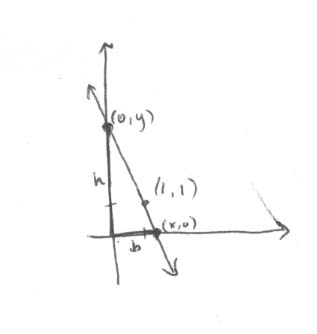Science:Math Exam Resources/Courses/MATH110/April 2011/Question 07 (c)
{{#incat:MER QGQ flag|{{#incat:MER QGH flag|{{#incat:MER QGS flag|}}}}}}
• Q1 (a) • Q1 (b) • Q1 (c) • Q2 (a) • Q2 (b) • Q3 (a) • Q3 (b) • Q3 (c) • Q4 (a) • Q4 (b) • Q4 (c) • Q5 • Q6 • Q7 (a) • Q7 (b) • Q7 (c) • Q8 (a) • Q8 (b) • Q8 (c) • Q8 (d) • Q8 (e) • Q8 (f) • Q9 •
Question 07 (c) |
|---|
|
As long as , the line you gave as an answer in part (a) cuts out a triangle in the upper righthand quadrant, whose vertices are at the origin, the x-intercept, and the y-intercept. Find m so that the area of this triangle is as small as possible. |
|
Make sure you understand the problem fully: What is the question asking you to do? Are there specific conditions or constraints that you should take note of? How will you know if your answer is correct from your work only? Can you rephrase the question in your own words in a way that makes sense to you? |
|
If you are stuck, check the hint below. Consider it for a while. Does it give you a new idea on how to approach the problem? If so, try it! |
Hint |
|---|
|
Draw a picture of a line and label the sides of the triangle that is formed. How could you write each side in terms of ? |
|
Checking a solution serves two purposes: helping you if, after having used the hint, you still are stuck on the problem; or if you have solved the problem and would like to check your work.
|
Solution |
|---|
|
The question is asking us to minimize the area of a triangle. So the function that we will be minimizing is where b is the triangle's base and h is its height. In order to optimize (in this case, minimize), we need to reduce this formula to a function of one variable. If we draw a picture of a line with negative slope that passes through (1,1), we will see the triangle formed by the axes and the line and can label its base and height.
We now take the derivative of A... ...and find its critical points. The derivative is undefined when . Setting it equal to zero: yields additional critical points of and . However, as stated in the question, , so the only valid critical point is . To check that this is a minimum, you could use the first or second derivative test. |
{{#incat:MER CT flag||
}}












